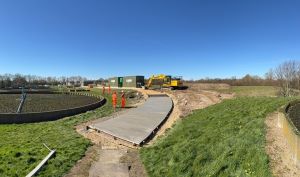A new low-carbon Concrete developed through collaboration between the Graphene Engineering Innovation Centre (GEIC) at the University of Manchester, Cemex UK, Galliford Try, Sika, and Northumbrian Water has been successfully poured at a wastewater treatment facility, marking a major step in decarbonising construction materials. The 15m³ pour of graphene and micronised lime-enhanced concrete achieved up to a 49% reduction in CO? emissions per cubic metre compared to traditional CEM I concrete, while maintaining comparable strength performance.
Developed at the GEIC and Cemex’s National Technical Centre, the mix-named CoMLaG (Combining Micronised Limestone and Graphene) – uses a ternary cement blend. This replaces a portion of high-carbon clinker with GGBS and micronised limestone, while graphene enhances strength at very low doses (<0.1%).
Following lab trials, the team successfully scaled production at a North East batch plant, using site-available materials. Real-time strength development was monitored using Cemex’s i-Con maturity system, validating performance under real conditions. The mix achieved a 28-day compressive strength of 78.3 N/mm², closely matching the 82.6 N/mm² of the CEM I control.
“This project is a fantastic example of industry-led project with significant contributions from University of Manchester research facilities to reduce carbon emissions in construction,” said Lisa Scullion, Application Manager at the GEIC. “Graphene-enhanced systems like CoMLaG open the door to concrete that performs well while significantly cutting its environmental impact.”
The next phase of work will focus on optimising the mix, improving admixture compatibility, and validating performance across a wider range of aggregates to support commercial rollout.
